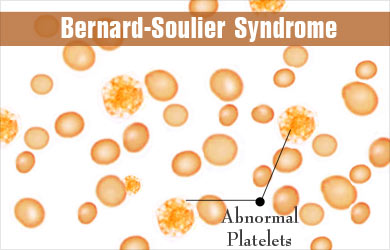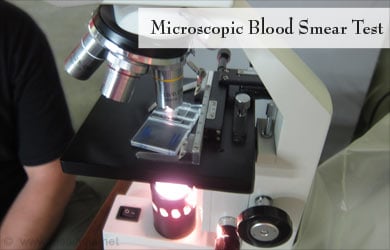- Berndt MC, Andrews RK. Bernard-Soulier syndrome. Haematologica. 2011;96(3):355-359. doi:10.3324/haematol.2010.039883.
- Pham A, Wang J. Bernard-Soulier syndrome: an inherited platelet disorder. Arch Pathol Lab Med. 2007;131(12):1834-1836.
- Savoia A et al. Spectrum of the mutations in Bernard-Soulier syndrome. Hum Mutat. 2014;35(9):1033-1045.
- Bernard-Soulier Syndrome - (https://rarediseases.org/rare-diseases/bernard-soulier-syndrom)
- Lanza F. Bernard-Soulier syndrome (hemorrhagiparous thrombocytic dystrophy). Orphanet J Rare Dis. 2006;1:46.
What is Bernard-Soulier Syndrome?
Bernard-Soulier Syndrome (BSS) is a rare hereditary platelet bleeding disorder. Lack of a functional glycoprotein receptor complex causes blood clotting defects. Bleeding is the main symptom in BSS.
In 1948, Jean Pierre Soulier and Jean Bernard discovered a bleeding disorder in a male patient who was the offspring of a marriage between close relatives. They termed this condition Bernard-Soulier syndrome. Bernard-Soulier syndrome (BSS) is a rare blood disorder of the platelets. It is a hereditary autosomal recessive disorder. Patients with BSS have large platelets, thrombocytopenia and a longer bleeding period. The major cause for this bleeding was discovered to be the lack of a glycoprotein receptor complex ((Gp)-Ib-IX-V) that coats the platelet wall. The discovery was made in 1975 by researchers, Nurden and Caen, where they observed a mutation in the genes encoding the ((Gp)-Ib-IX-V) complex.

Bernard-Soulier syndrome affects both genders and is normally seen in families where marriages occur between relatives. The exact prevalence rate of this disease in the world is not clear due to underreporting of this condition but estimates set the rate as one affected individual out of 1000000. Bernard-Soulier syndrome carriers do not show any adverse symptoms apart from certain instances of mild bleeding.
What are the Causes of Bernard-Soulier Syndrome?
The main cause of Bernard-Soulier disease is the absence of a functional glycoprotein receptor complex ((Gp)-Ib-IX-V) that coats the platelet wall. The absence or abnormality in this receptor causes a deficiency in the functioning of the ((Gp)-Ib-IX-V) complex. The platelets fail to stick to the blood vessel walls and blood clots do not form. The ((Gp)-Ib-IX-V) receptor has 4 subunits. Mutations have been observed in 3 (GPIX, GPIBa and GPIBb) of the 4 subunits. The genes involved are the GP1BA, GP1BB, and the GP9 genes. Variations in the manifestations of BSS are due to the differences in mutations in the ((Gp)-Ib-IX-V) receptor. So far, 22 unique changes and 112 variations have been observed in the ((Gp)-Ib-IX-V) receptor.
What are the Symptoms and Signs of Bernard-Soulier Syndrome?
One of the primary symptoms of Bernard-Soulier syndrome is excessive bleeding. Due to defects in the ((Gp)-Ib-IX-V) receptor complex, clotting is absent as platelets are unable to stick.
- Bleeding symptoms are observed in babies immediately after birth or in children during their early years of growth.
- Bleeding is observed in the skin, nose and gums.

- Another source of bleeding is during surgery or following a trauma (e.g., an accident, dental treatment or circumcision).
- Gastrointestinal bleeding is also observed in patients with BSS.
- Women experience severe menstruation bleeding.
- Other signs of the disease are low blood platelet counts and the presence of abnormally large platelets.
- Some patients with BSS show red spots due to bleeding from small blood vessels below the skin. Such spots are known as purpura or petechiae. Patients with BSS tend to get bruised easily.
How to Diagnose Bernard-Soulier Syndrome?
Bernard-Soulier syndrome is diagnosed with bleeding rate tests, blood smear tests, genetic tests and platelet glycoprotein analysis. A medical history of the patient and immediate family is also taken.
Many laboratory tests are performed to make a confirmatory diagnosis. One of the tests is to analyze the time it takes for the skin to stop bleeding. In patients with BSS, the bleeding time ranges from 5 to 10 minutes to an extended bleeding time that is more than 20 minutes.
Microscopic blood smear tests examine the morphology of platelets. In general, patients with BSS have few platelets with large and round shapes. Platelet blood counts are examined to determine if the patient has BSS. In such cases, the platelet count ranges from 20 000 to 100 000/ml.

Flow cytometry analyzes confirm the diagnosis of platelet asymmetry. Reduced platelet aggregation in response to coagulating factor thrombin confirms the BSS condition in individuals. In addition, genetic tests can identify mutations in the ((Gp)-Ib-IX-V) receptor complex. Other laboratory tests involve the detection of platelet glycoproteins.
What are the Treatments for Bernard-Soulier Syndrome?
Bernard-Soulier syndrome is treated with the following:
- Antifibrinolytic medicines such as tranexamic acid are used to prolong the time required to disintegrate clots.
- Platelet transfusion is recommended to treat the bleeding symptoms in Bernard-Soulier syndrome. However, platelet transfusions carry the risk of generating antibodies within the body towards the transfused platelets. Hence, it is advisable to transfuse blood from HLA-matched donors.
- Acetaminophen medications, such as Tylenol, are recommended to relieve the pain in this condition.

How to Prevent Bernard-Soulier Syndrome?
Prevention of BSS is only possible through pre-natal counseling and testing to avoid hereditary transmission of genes causing the syndrome.
Health Tips
Patients with BSS should be well informed of their condition and take adequate precautions. They should be aware that during surgery or in the case of an accident or trauma, there is a possibility of excess bleeding and adequate precautions should be taken.
Patients with BSS should avoid using blood thinners, nonsteroidal anti-inflammatory drugs (e.g. ibuprofen), and aspirin, since bleeding may become severe.






